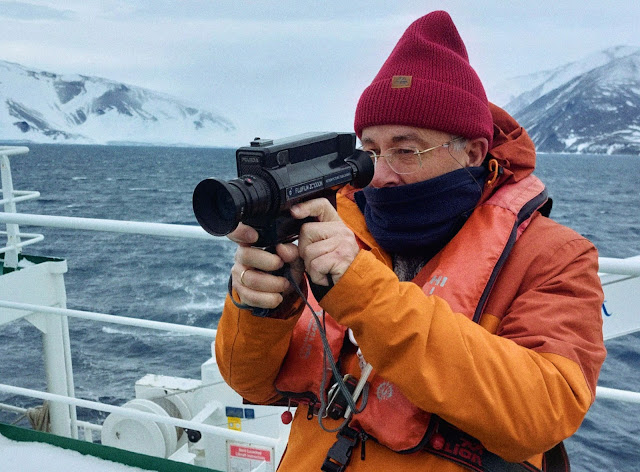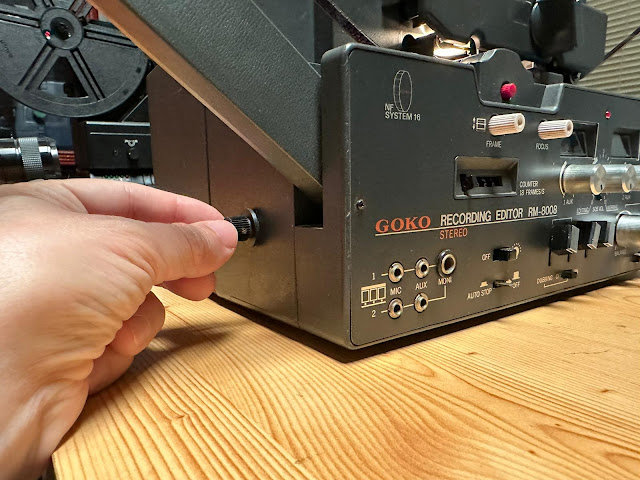My friend, the Japanese film producer Tak Kohyama (also owner of Retro Enterprises), interviewed yesterday to the great and only one Shigeo Mizukawa, the engineer whose greatest creation, the ZC1000, has gone down in history as the best motion picture film camera ever designed (an honor that Ivan Watson accurately predicted "will retain forever" , at this point in the film of story of film industry).
The ZC1000, which went into production half a century ago, has carried in my life fifty years of tireless victories, from the sands of the desert to the frozen Antarctic. I still film with the ZC1000, refilling the film cartridges with Kodak film personally.
 |
| Shigeo Mizukawa with Tak Kohyama |
- The ZC1000 has features that no other film camera offers or will have:
MOUNT FOR INTERCHANGEABLE LENSES.
Only a few cameras offer this feature, essential for my use: most of the Beaulieu models, the Leicina Special and the ZC1000; The winners are the Leicina Special and the ZC1000 for their extremely resistant mounts capable of withstanding very heavy lenses (but it is necessary to clarify that the Leicina uses a special bayonet from the brand, while in the Beaulieu, although they have a universal C mount, there are quite a few lenses that cannot be focused). In the case of the ZC1000, with a truly compatible C-mount, this one is also made of bronze!, like the giant Talos.
VARIABLE SHUTTER ADJUSTABLE IN ANY POSITION.
In the Leicina Special the shutter is fixed. In the Canon 1014 XLS, which only allows filming in two positions, 150 and 220 degrees, shutter is electronic, prone to faliure, specially in hard situations. The variable shutter is essential not only because I usually shoot, for a sharper frame, at 120 ºC, but, sometimes, and with film over 100 ASA, the only way to reduce the light without filters (which I prefer not to use) is with the shutter at 80º and even at 40º, with whose apertures it is as if I were shooting the 100 ASA at 50 and 25 ASA respectively.
DIRECT LIGHT PATH FROM THE LENS TO THE FILM, without passing through prisms or semi-transparent glass.
Only the Beaulieu and the ZC1000 offer this feature thanks to their guillotine mirror that alternatively allows all of the light to pass to the film or the viewfinder. This technology, in addition to allowing you to enjoy a very bright image in the viewfinder, produces a flicker that mesmerizes the cameraman, with a supreme cinematic sensation that makes you feel that the cinema is flowing onto your retina. There is a problem with the Beaulieu: its mirror is also a shutter, which on certain occasions produces some exposure errors. On the other hand, the ZC1000, in addition to the oscillating mirror, has its own circular variable shutter, for perfect exposures in difficult situations. In addition, it is faster: on the ZC1000, in low light conditions, at 24 frames per second, it allows you to shutter at 1/54 compared to 1/87 on the Beaulieu 4008.
LOW ENERGY CONSUMPTION.
ZC1000 requires very little power: just four regular AA batteries (except when shooting at 72 frames per second). When the camera is on but not working only consumes 10 mA (compared to 40 mA for the Bauer, and even more for other models). The consumption, filming at 24 f.p.s on the ZC1000 is 360 mA.
The battery compartment is very well insulated, it can be replaced with a warmer one in a matter of seconds and, in addition, the camera has its own special leather exterior battery compartment for low temperatures.
 |
| Mini camera, in this configuration |
TRANSFORMABLE INTO A MINI CAMERA.
In my latest documentary in Antarctica, some of my filming would be in a mini helicopter with only one rotor, with very little space. The only cameras that can be adapted are: the ZC1000N with the Fujinon 5.5 mm lens and a Soviet grip instead of the normal one or the Leicina Special with the excellent Cinegon 10 mm fixed focal.
ERGONOMICS AND GRIP.
I really appreciate that while I hold the grip with one hand and hold the lens with the other, at the same time, I can rest it firmly on my forehead. Only Leicina, the Bauer A512 and the Fujica ZC1000 score in this category, with the ZC1000 being the winner due to the extreme ergonomics of its handle, the availability of two electromagnetic release triggers and the provision with not one, not two, but no less than three tripod threads (up to 4, on certain models!), one of them on the top, very useful in certain special shoots that a documentary filmmaker who works as a lone wolf comes across.
 |
| Mini camera!, in this configuration |
SUPREME FRAME STEADINESS.
The ZC1000N provides a picture steadiness unattainable by any Super-8 camera (the closest is the Nikon R10), thanks to two features of the Single-8 system: 1) the in-camera metal pressure pad, which firmly presses the film against the window, instead of being "floating" as in Super-8; and 2) pull of the film after the window, and not before as in Super-8 cartridges (in position -3 to -2); The ZC1000, in addition, has a double claw, after the gate window, that pulls from frames +2 and +3 to +3 and +4. Another additional claw, above the window, pulls the film in reverse when it is necessary to shot in reverse without changing the frame line.
 |
| Double claw here in +3 and +4 |
CIRCULAR IRIS WITH MANUAL CONTROL.
Leicina Special has a very ugly rectangular-looking iris of its 6-66mm lens. The most comfortable system meter control, for handling with gloves, is the one the ZC1000 has: there are no automations to disconnect or break down since the exposure adjustment is always manual.
 |
| My interview to Shigeo in Tokyo in 2004, for the British magazine "International Movie Making" and the German "Schmall Film" |
REVERSE FILMMING THROUGHOUT THE ENTIRE LENGTH OF THE FILM AND WITHOUT VARIATION IN THE HEIGHT OF THE FRAMING LINE.
Only the ZC1000 meets this requirement, described above. Many of the effects achieved with this technique can be replicated in post-production, but myself prefer do this effects during the shooting
MECHANICAL FRAME COUNTER, EVEN REGRESSIVE. Another exclusive advantage gives the ZC1000. The Beaulieu 7008 Pro and 9008 also have a frame counter but it is not mechanical, but electronic, with an LCD panel that does not work at extremely low temperatures.
LENS WITH MACROFOCUS AT ANY FOCAL LENGTH.
Only the ZC1000 offers this technical feature using ALL THE FOCAL LENGHTS.
RELIABLE METHOD OF CONTROLLING FILM ADVANCE IN FORWARD OR REVERSE.
One of the defects that makes me most nervous about Super-8 cameras is that, especially in timelapse filming, it is not possible to know if the cartridge is advancing correctly. This does not happen, however, with the ZC1000 because, like all Single8 cartridge cameras, a small porthole-type window allows you to observe the rotation of one of the cartridge's axes.
SLOW MOTION.
We can only count here on the Beaulieu and the ZC1000, the latter being my favorite due to the greater stability of the image filmed at 72 frames per second, a merit not only of the pressure pad in the camera but also of the direct path of the film in the cartridge.
LOW NOISE AT 24 F.P.S.
Of top level cameras, quietest, in my opinion, are the Beaulieu 9008 and the Canon 1014 XLS but a well maintened ZC1000N is very near.
FACILITY FOR SYNCHRONOUS SOUND RECORDING. ZC1000 which allows you to use both Cine Assist (digital sound recorded with your mobile phone) and FTS (in sync with a Sony WM-D6C stereo tape recorder). Of course, the old Puls Sync system, too.
THE BEST GOOD LENS COATING.
My favorite is Fuji's EBC of the original ZC1000 lenses, which is applied electronically and doesn't peel off or degrade over the years. The Schott T-coating that can be found on the Leicina, the Nizo Professional and the Bauer A512 Mark II is very good but it has an Achilles heel: a rear group of lenses from these Schneider optics, glued with Canada balsam, to these heights of its life it presents, in special light conditions, a halo effect: its cleaning is only within the reach of experienced optics experts at a very expensive cost.
SUMMARY. ZC1000 (1974 - 2024) 50 YEARS OF VICTORIES. The Fujica ZC1000N, introduced in 1974 (half a century ago!), emerges as the true champion. From its superior ergonomics, reliability, and ability to shoot in reverse without change in the frame line, to impressive slow speed and a foolproof method of film advance verification, this camera stands as the ultimate choice for a serious filmaker specillay in extreme locations and without possibilities for "surgical" interventions.
 |
| Shigeo and Tak, yesterday |
THE COUNTERPOINT. Nothing is perfect and everything has its Achilles heel. In this case, it is not due to the camera but to the film loading system: the ZC1000 is designed to film with single-8 cartridges, which were marketed by Fuji between 1965 and 2013. In this type of cartridges, to fit fifteen meters, the film base is required to be made of polyester, which, unfortunately, is no longer available, having to use the much inferior (for archival purposes over centuries) triacetate (also less flexible at low temperatures) and which, as it is thicker , only accept 10-12 meters per cartridge (only about 90 seconds of filming at 24 frames per second!). Film must be preloaded in the cartridges by the filmmaker himself, as no commercial film is available in Single-8 cartridges (except very small batchs by Retro Enterprises or Click & Surr).
 |
| Photograph of Shigeo with a prototype of ZC1000 in wood!, presiding the HAL 9000 room in my small production film company |
.jpg)

















.jpg)












